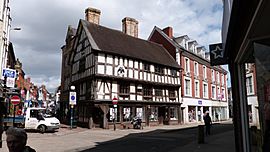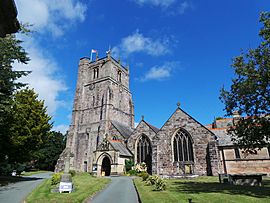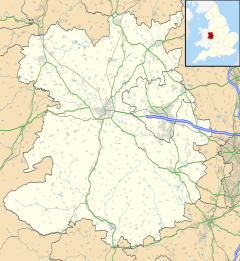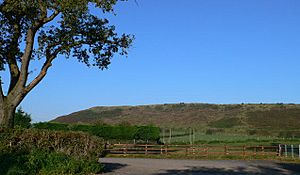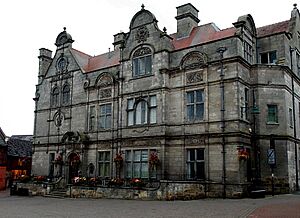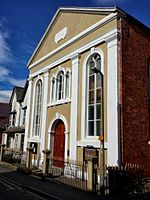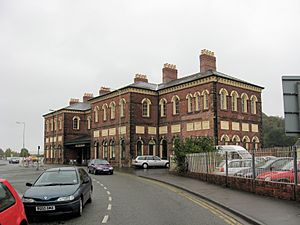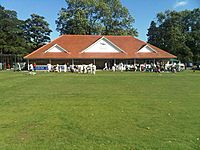Oswestry facts for kids
Quick facts for kids Oswestry
|
|
|---|---|
|
Clockwise from top: Llwyd Mansion, Cross Street, St Oswald's Church, Oswestry Market |
|
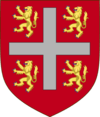 Coat of arms of Oswestry Motto: Floreat Oswestria ('May Oswestry flourish') |
|
| Population | 17,509 (2021 Census) |
| OS grid reference | SJ292293 |
| • London | 179 mi (288 km) SE |
| Civil parish |
|
| Unitary authority |
|
| Ceremonial county | |
| Region | |
| Country | England |
| Sovereign state | United Kingdom |
| Post town | OSWESTRY |
| Postcode district | SY10, SY11 |
| Dialling code | 01691 |
| ISO 3166 code | GB-SHR |
| Police | West Mercia |
| Fire | Shropshire |
| Ambulance | West Midlands |
| EU Parliament | West Midlands |
| UK Parliament |
|
| Councillors |
|
Oswestry is a lively market town in Shropshire, England. It is very close to the Welsh border. The town is located where the A5, A483, and A495 roads meet.
Oswestry was once the main town for the Borough of Oswestry until 2009. It is the third-largest town in Shropshire. Only Telford and Shrewsbury are bigger. In 2021, about 17,509 people lived here. The town is just five miles (8 km) from Wales. It has a mix of English and Welsh history and culture.
Oswestry is the biggest town in the Oswestry Uplands. This area is known as a special "natural area" in England.
Contents
What's in a Name?
The name Oswestry was first written down in 1191. It was called Oswaldestroe back then. This old name comes from the Old English name Ōswald and the word trēow, which means 'tree'. So, it might have meant 'tree of a man called Ōswald'.
The Welsh name for the town is Croesoswallt. This name was first seen in 1254. It means 'Oswald's cross'. The word 'cross' can also be a meaning for the Old English word trēow. So, the town's name might have meant 'Oswald's cross' in both English and Welsh.
Many people think the Oswald in the name was Oswald of Northumbria. He was a king who died in a battle in 641 or 642. This battle, called the Battle of Maserfield, is thought to have happened in Oswestry. However, experts are not completely sure about the exact battle location.
Some people believe Oswestry was named after Oswy. He was Oswald's brother. Oswy fought a battle here against King Penda in 655 AD. This battle was near a river called the Winwead, which is thought to be the nearby River Vyrnwy.
A Look Back in Time
Early Times
The oldest known settlement in Oswestry is Old Oswestry. This is one of the best-preserved Iron Age hill forts in the country. People built and lived here between 800 BC and 43 AD. In Welsh, it's called Caer Ogyrfan. This means 'City of Gogyrfan', who was a character in Arthurian legends.
Saxon Era
The Battle of Maserfield is believed to have taken place in Oswestry in 641 or 642. This battle was between the Anglo-Saxon kings Penda of Mercia and Oswald of Northumbria. But, as mentioned, the exact spot of the battle is still debated by historians.
The Norman Conquest
The Domesday Book from 1086 mentions that the castle was built by Rainald. He was a Norman Sheriff of Shropshire.
Alan fitz Flaad was a knight from Brittany. King Henry I gave him land in Oswestry around 1120. Alan's job was to watch over the Welsh border. His son, William FitzAlan, became Sheriff of Shropshire in 1137. Alan's younger son, Walter, moved to Scotland. He became the first hereditary Steward of Scotland and an ancestor of the Stewart Royal family.
A Town on the Border
Oswestry was often controlled by either the English or the Welsh during the Middle Ages. Because of this, some street and place names in the town are still in Welsh.
In 1149, Madog ap Maredudd captured the castle. It stayed in Welsh hands until 1157. Later, in 1400, the Welsh rebel leader Owain Glyndŵr attacked Oswestry. He burned most of the town. It became known as Pentrepoeth, meaning "hot village". The castle was destroyed during the English Civil War.
Today, Oswestry is home to the Shropshire libraries' Welsh Collection.
A Busy Market Town
In 1190, Oswestry was allowed to hold a market every Wednesday. The town built walls for protection. However, these walls were pulled down by the Parliamentarians in 1644. This happened after they took the town from the Royalists during a short siege. Only the Newgate Pillar can be seen today.
The animal market moved out of the town centre after a foot and mouth disease outbreak in the 1960s. In the 1990s, a statue of a shepherd and sheep was put in the market square. It reminds people of the town's market history.
Military History
Park Hall, just east of Oswestry, was used by the Army in World War I. It became a training camp and hospital in 1915. In 1918, it burned down. The ruined camp stayed empty for many years. However, the camp hospital was still used. It became the Robert Jones and Agnes Hunt Orthopaedic Hospital.
In the 1920s, the land was also used for motorcycle racing. It became a well-known race track.
The camp was used again in 1939 for Royal Artillery training. After World War II, Oswestry was an important military centre. It was used by Canadian troops, then the British Royal Artillery. Finally, it was a training centre for young Infantry Junior Leaders. The camp closed in 1975.
Today, the area where the military camp was is mostly homes and farms. Park Hall Farm opened as a visitor attraction in 1998. It has the Museum of the Welsh Guards.
Famous Places
Old Oswestry is on the northern edge of the town. It is a 3,000-year-old settlement. It is one of the most amazing and well-preserved Iron Age hill forts in Britain. People built and lived there between 800 BC and 43 AD.
Other interesting places in Oswestry include:
- Cae Glas Park
- Shelf Bank
- Wilfred Owen Green
- Saint Oswald's Well at Maserfield
- Oswestry Castle
- The Cambrian Railway Museum, near the old railway station.
The Oswestry Guildhall is where the Oswestry Town Council meets. It was finished in 1893.
There is a tapestry of forty Oswestry pub signs in the Oswestry Guildhall. The Stonehouse Brewery opened in 2007. It supplies many local pubs with real ale.
Brogyntyn Hall is just outside the town. Brogyntyn Park is a large parkland area. It was given to Oswestry Town Council in 1952.
Arts and Fun
Oswestry has many activities related to arts and culture:
- The Qube
- Oswestry Visitor & Exhibition Centre
- Willow Gallery
- The Oswestry Town Museum
- Cambrian Railways Museum
- Attfield Theatre
- Fusion Arts, which organises arts and music for young people.
- Kinokulture, a cinema (closing by April 2024).
- Hermon Chapel Arts Centre
- Oswestry Choral Society, Oswestry Recorded Music Society, and Oswestry Ladies Choir.
- OsRocks Choir
- Wilfred Owen Green
- Borderland Visual Arts, a group of local artists.
- Borderlines Film Festival
- The Oswestry Food and Drink Festival
- Oswestry Balloon Carnival
- The Whittington International Chamber Music Festival
Royal Visitors
Members of the Royal Family have visited Oswestry:
- The Duchess of Edinburgh visited in 2023.
- The Princess Royal visited in 2021.
- Princess Alexandra visited in 2017.
- The Duke of Gloucester visited in 2011.
Places of Worship
In the 2011 Census, most people in Shropshire (68.7%) said they were Christian. The next largest group (22.8%) said they had no religion.
Oswestry has several places of worship. The town has two Church of England parishes: Holy Trinity and St. Oswald. Each has its own church. St Oswald's Church was first mentioned in 1086. It is a very old building with parts from the 12th century.
There is also a Roman Catholic church, Our Lady and St Oswald's Catholic Church. It has a primary school linked to it.
Other churches include two Methodist churches, a Baptist Church, and several other Nonconformist churches. There is a Welsh-speaking church called Seion Church.
A small Muslim community lives in Oswestry. Plans were approved in 2019 to turn a former Salvation Army building into an Islamic Prayer Centre.
There is also a small Orthodox Christian community. Many people from Bulgaria live in the town.
Health Services
The Robert Jones and Agnes Hunt Orthopaedic Hospital NHS Trust is near Oswestry. It provides special bone and muscle surgery and medical services. This hospital is located towards Gobowen.
The hospital also has the UK's first outpatient centre for British Armed Forces veterans.
There is a Health Centre on Thomas Savin Road. It has the Oswestry Minor Injuries Unit and Cambrian Medical Centre. There are also other GP surgeries, opticians, pharmacists, and dentists in the town.
Learning and Schools
Oswestry is home to Oswestry School, which started in 1407. It is the second oldest 'free' school in the country. 'Free' here means it was not linked to a church. The school's old 15th-century site is now a café restaurant.
There are four state primary schools in Oswestry:
- The Meadows Primary School
- Woodside Primary School
- Holy Trinity C.E. Primary Academy & Nursery
- Our Lady & St. Oswald's Catholic Primary School
There is also an independent school for younger children called Bellan House.
For older students, there is Oswestry School and The Marches School. The Marches School also has a Sixth Form for further education. The North Shropshire College also provides further education in the town.
Local News and Radio
Local TV news comes from BBC West Midlands and ITV Central. Local radio stations include BBC Radio Shropshire (96.0 FM), Hits Radio Black Country & Shropshire (103.1 FM), and Greatest Hits Radio Black Country & Shropshire (107.1 FM).
The local newspapers are the Border Counties Advertizer and the Shropshire Star.
Getting Around
Oswestry is at the meeting point of the A5, A483, and A495 roads. The A5 goes north from Shrewsbury, past the town, and into Wales.
Bus services are run by several companies. They link Oswestry to nearby villages and towns like Wrexham, Welshpool, and Shrewsbury. There is also a special Dial-A-Ride minibus service.
Gobowen railway station is about 2 miles from Oswestry. You can catch direct trains there to Birmingham, Cardiff, Chester, and North Wales. The old sign "Gobowen for Oswestry" is still on the platform.
Canals
The Llangollen Branch of the Shropshire Union Canal passes about 4.5 miles east of Oswestry. A part of the Montgomery Canal has also been restored.
Old Railways
The railway station used to be on the main line of the Cambrian Railways. It closed in 1966. The main building of the old Cambrian station is still in the town centre. It used to be the headquarters for the Cambrian Railways company.
After being restored, this building reopened as the Cambrian Visitor Centre in 2006. It is now the headquarters of the Cambrian Heritage Railways (CHR). It also has a small café called "Buffers" and some shops.
A single railway track still runs through the station. There are plans to reopen the line as a steam heritage railway. This would connect Oswestry to Llanyblodwel and Pant. It would also link Oswestry to the National Rail station at Gobowen.
Work is ongoing to make this happen. The aim is to have the railway line between Gobowen and Oswestry fully working again.
Next to Oswestry Railway Station is the Cambrian Railways Museum. A short distance north are the old Cambrian Railways works. These are now used by local businesses and a health centre.
Sports Fun
From 2013, the town had a football team called F.C. Oswestry Town. They stopped playing in 2020. The older local football club, Oswestry Town F.C., was one of the few English teams to play in the Welsh Premier League. They won the Welsh Cup three times.
In 2003, the club joined with another team and was renamed The New Saints (TNS). They moved to the Park Hall Stadium in Oswestry in 2007. TNS is a professional football club. They play in the Welsh Premier League and have won it many times.
Oswestry Lions F.C. also play at the ground.
Fun and Free Time
From the 1700s to 1848, there was a popular racecourse outside the town. It was called Cyrn-y-Bwch (Welsh for 'the Horns of the Buck'). This racecourse was on a high hilltop. It was chosen because it was between England and Wales. The idea was to bring people from both sides together. You can still see parts of the old race track today.
Now, Oswestry Race Course is common land. This means it's a public space for everyone to use. It's a place for:
- Quiet, fun activities and recreation.
- Protecting the different plants and animals that live there.
- Managing and looking after nature and wildlife.
The site offers great views across the countryside of England and Wales.
The Offa's Dyke Path National Trail crosses this common land.
Twin Towns
Oswestry is twinned with Combs-la-Ville, France. They became twin towns in 1980.
Famous People from Oswestry
Arts and Media
- Guto'r Glyn (c1412-c1493) – A Welsh poet.
- Shirley Brooks (1816–1874) – A journalist and novelist.
- William Archibald Spooner (1844–1930) – An Oxford teacher known for "spoonerisms" (mixing up sounds in words).
- Sir Henry Walford Davies (1869 in Oswestry – 1941) – A composer.
- Wilfred Owen (1893 in Oswestry – 1918) – A famous poet and soldier from World War I.
- Ivor Roberts-Jones (1913 in Oswestry – 1996) – A sculptor.
- Barbara Pym (1913 in Oswestry – 1980) – A novelist.
- Ian Hunter (born 1939 in Oswestry) – Lead singer of the rock band Mott the Hoople.
- Paul Jerricho (born 1948 in Oswestry) – An actor.
- Peter Edwards (born 1955) – An award-winning artist.
Public Service
- Roger Palmer, 1st Earl of Castlemaine (1634–1705) – A courtier and diplomat.
- Harold Whitfield (1886–1956) – A soldier who received the Victoria Cross.
- Trevor Rees-Jones (1968-) – A bodyguard for Princess Diana.
Science, Medicine, and Business
- Thomas Mainwaring Penson (1818 in Oswestry – 1864) – A surveyor and architect.
- Thomas Savin (1826 in Llwynymaen – 1889 in Oswestry) – A railway engineer.
- Edward Weston (1850 in Oswestry – 1936) – A chemist who worked in the USA.
- Dame Steve Shirley (born 1933) – A pioneer in information technology and businesswoman.
- Sir Malcolm Walker (born 1946) – Founded the Iceland supermarket chain in Oswestry in 1970.
- Per Lindstrand (born 1948) – A Swedish engineer and pilot who founded Lindstrand Balloons in Oswestry.
- Ian Robertson (born 1958 in Oswestry) – An automotive executive at BMW Group.
Sports
- Di Jones (1867 in Trefonen – 1902) – A Welsh international footballer.
- Herbie Roberts (1905 in Oswestry – 1944) – A footballer for Arsenal F.C.
- Alan Ball, Sr (1924-1982) – A football player and manager.
- Alan Ball, Jr (1945-2007) – An England football player who won the 1966 World Cup.
- Andy Lloyd (1956 in Oswestry) – An England test cricketer.
- Ian Woosnam (born 1958 in Oswestry) – A Welsh professional golfer.
- Matt Done (born 1988 in Oswestry) – A professional footballer.
See Also
 In Spanish: Oswestry para niños
In Spanish: Oswestry para niños


